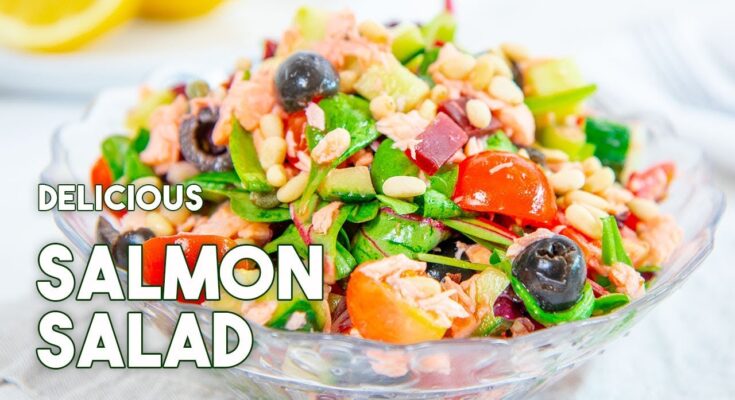Salmon Salad Recipe: Salmon salad is not just a treat for your taste buds—it’s a nutritional powerhouse packed with protein, omega-3 fatty acids, and antioxidants. Whether you’re looking for a quick weekday lunch or an elegant dinner option, this salad checks all the boxes. It’s light, refreshing, and customizable to suit your flavor preferences.
This step-by-step guide will help you create a perfect salmon salad, whether you prefer it grilled, baked, or even made with canned salmon. Along the way, we’ll share tips on choosing ingredients, assembling the salad, and adding creative twists to keep things exciting.
If you’re ready to create a mouthwatering salmon salad, let’s get started!
Ingredients and Tools You’ll Need
Main Ingredients:
- Salmon Fillet (Fresh or Canned) – 200–300 grams
- Mixed Salad Greens – 4 cups (arugula, spinach, or lettuce)
- Cherry Tomatoes – 1 cup, halved
- Cucumber – 1 medium, sliced thinly
- Red Onion – ½, finely sliced
- Avocado – 1, diced
Optional Ingredients for Variations:
- Nuts and Seeds – Almonds, sunflower seeds, or walnuts
- Fruits – Berries, mango, or apple slices for sweetness
- Cheese – Feta, goat cheese, or Parmesan shavings
- Carbs – Quinoa, pasta, or croutons for added texture
Essential Tools and Utensils:
- Sharp knife for slicing vegetables
- Cutting board
- Mixing bowl and salad tongs
- Grill pan or baking tray (for cooking salmon)
- Whisk or blender (for making dressing)
Step 1: Preparing the Salmon
Choosing the Right Salmon
Fresh salmon is ideal for this recipe, but canned salmon is a great alternative if you’re short on time. Look for wild-caught salmon for better flavor and nutritional value.
Cleaning and Seasoning the Salmon
- Cleaning: Rinse the salmon fillet under cold water and pat it dry with paper towels.
- Seasoning: Rub the fillet with olive oil, salt, pepper, garlic powder, and a dash of paprika or chili flakes for added spice.
Cooking Methods:
- Grilled: Preheat the grill and cook the fillet for 3–4 minutes per side until golden and flaky.
- Baked: Place the seasoned fillet on a baking sheet and bake at 400°F (200°C) for 12–15 minutes.
- Pan-Seared: Heat a tablespoon of olive oil in a pan and cook the salmon for 3–4 minutes on each side until crispy.
Once cooked, let the salmon cool slightly before flaking it into bite-sized pieces.
Step 2: Prepping the Vegetables and Greens
Best Greens for Salmon Salad:
Opt for dark leafy greens like spinach, arugula, or mixed spring greens. These provide a rich source of vitamins and create a fresh base for the salad.
Chopping Techniques for Freshness:
- Tomatoes: Slice cherry tomatoes in half for bite-sized pieces.
- Cucumber: Cut thin slices for a crunchy texture.
- Red Onion: Use a sharp knife to create paper-thin slices to avoid overpowering flavors.
- Avocado: Dice just before serving to prevent browning.
Additional Veggie Options:
- Add bell peppers, shredded carrots, or radishes for extra crunch.
- Incorporate roasted sweet potatoes or beets for earthy flavors.
Step 3: Making the Dressing
Ingredients for Classic Vinaigrette:
- Olive Oil – 3 tablespoons
- Lemon Juice – 2 tablespoons
- Dijon Mustard – 1 teaspoon
- Honey – 1 teaspoon
- Salt and Pepper – to taste
Alternative Dressings:
- Creamy Dressing: Use Greek yogurt or mayonnaise mixed with lemon and dill.
- Citrus Dressing: Combine orange juice, lime, and honey for a zesty kick.
- Asian-Style Dressing: Mix sesame oil, soy sauce, ginger, and rice vinegar.
Blending the Perfect Dressing:
Whisk together the ingredients until emulsified or shake them in a sealed jar for quick mixing. Taste and adjust seasoning if needed.
Step 4: Assembling the Salad
Layering Ingredients for the Perfect Presentation
Start by placing the mixed greens in a large salad bowl or on a serving platter. Spread them out evenly to create a fresh and vibrant base. Next, arrange the chopped vegetables—tomatoes, cucumbers, red onions, and avocado—on top of the greens. Ensure each ingredient is distributed evenly to create a balanced look.
For the salmon, gently flake it into bite-sized chunks and place it over the vegetables. You can keep the pieces slightly larger for a rustic appearance or shred them finer for a more integrated texture.
Balancing Flavors and Textures
Add nuts and seeds, such as almonds, sunflower seeds, or pumpkin seeds, for extra crunch. If you enjoy a hint of sweetness, toss in some dried cranberries, pomegranate seeds, or sliced mango. Crumbled feta or goat cheese can also enhance the flavor profile, giving it a creamy finish.
To boost the protein content, consider adding hard-boiled eggs or chickpeas. For those who love carbs, cooked quinoa, brown rice, or croutons can make the salad more filling.
Adding Optional Toppings
Sprinkle freshly chopped herbs like parsley, dill, or cilantro to add brightness. A squeeze of fresh lemon juice just before serving can elevate the flavors even more.
Step 5: Final Touches and Serving Suggestions
Garnishing Ideas for Appeal
A beautifully garnished salad not only tastes better but also looks more inviting. Add microgreens or edible flowers for an elegant touch. If you like spice, a sprinkle of red pepper flakes can enhance the heat.
Serving Styles
- Single Plate Serving: Ideal for personal meals or small gatherings. Serve the salad in large, shallow bowls for a restaurant-style presentation.
- Large Bowl Serving: Perfect for parties and family dinners. Use a wide bowl that allows for easy mixing and serving.
Pair the salad with toasted garlic bread, pita chips, or a side of soup to make it a complete meal. It’s also a great companion to white wine or sparkling water with lemon slices for a refreshing beverage option.
Salmon Salad Variations and Customizations
Low-Carb and Keto-Friendly Options
Replace carb-heavy ingredients like croutons or pasta with extra greens, zucchini noodles, or roasted cauliflower. Use a high-fat dressing like avocado mayo or ranch to keep it keto-approved.
Vegan Alternatives
For plant-based options, swap the salmon with grilled tofu, tempeh, or chickpea patties. You can also find vegan salmon alternatives made from carrots or legumes, mimicking the taste and texture of fish.
Adding Grains for a Hearty Twist
Quinoa, couscous, or farro can turn your salad into a satisfying main course. Cook the grains beforehand, let them cool, and toss them in the salad for a wholesome addition.
Health Benefits of Salmon Salad
Nutritional Value of Salmon
Salmon is a nutritional powerhouse packed with lean protein, essential vitamins, and minerals. A 3-ounce serving provides about 20 grams of protein, supporting muscle growth and repair. It’s also an excellent source of B vitamins, potassium, and selenium.
Low-Calorie and Protein-Rich
For those focused on weight management, salmon salad is a low-calorie yet filling meal. The high protein content helps curb hunger, while the healthy fats keep you energized.
Heart Health Benefits
Rich in omega-3 fatty acids, salmon supports cardiovascular health by reducing inflammation and improving cholesterol levels. It’s also linked to better brain function and reduced risk of chronic diseases.
Including vegetables further enhances the salad’s nutritional value, adding fiber, vitamins, and antioxidants to protect your body from free radicals.
Storing Leftovers and Meal Prep Tips
How to Store Without Wilting
If you plan to save leftovers, store the dressing separately to prevent the greens from becoming soggy. Use airtight containers to keep the salad fresh for up to 2 days.
Reheating Tips for Cooked Salmon
For cooked salmon, store it in a separate container and reheat it gently in a skillet or microwave. Avoid overcooking to maintain its texture. Alternatively, enjoy it cold for a quick and easy meal.
Make-Ahead Prep for Busy Days
Prepare the ingredients in advance by chopping the vegetables and cooking the salmon. Store each component separately in the fridge and assemble the salad when you’re ready to eat. This makes it perfect for meal prepping lunches or dinners throughout the week.
FAQs about Salmon Salad Recipe
What are the best types of salmon for a salad recipe?
For salmon salad, opt for varieties like sockeye or king salmon, which are known for their robust flavor and firm texture. Canned salmon can also be a convenient and budget-friendly option.
How do I properly cook salmon for a salad?
To prepare salmon for a salad, you can either grill, bake, or poach the fish. Ensure it’s cooked through to an internal temperature of 145°F (63°C). Allow it to cool before flaking it into the salad to maintain its delicate texture.
What ingredients pair well with salmon in a salad?
Salmon pairs beautifully with greens such as arugula or spinach, fresh vegetables like cucumbers and cherry tomatoes, and a tangy dressing. Avocado, orange segments, or a sprinkle of feta cheese can add extra flavor and texture.
Can I make salmon salad ahead of time?
Yes, you can prepare salmon salad in advance. Cook the salmon, prepare the dressing, and chop the vegetables ahead of time. However, for the best texture and freshness, combine all the ingredients shortly before serving.
Is salmon salad healthy?
Salmon salad is very nutritious, offering a good source of omega-3 fatty acids, protein, and essential vitamins. By including a variety of vegetables and a light dressing, you can make a healthy meal that is both satisfying and beneficial for your health.
Conclusion
Making a salmon salad is as easy as it is rewarding. With fresh ingredients, a flavorful dressing, and endless customization options, this recipe is perfect for any occasion. Whether you’re looking for a healthy lunch, a light dinner, or an impressive dish to serve guests, salmon salad has you covered.
From prepping the salmon to assembling the perfect blend of greens and toppings, every step ensures a delightful eating experience. Plus, it’s packed with nutrients to keep you healthy and satisfied. So, why not give it a try today?



